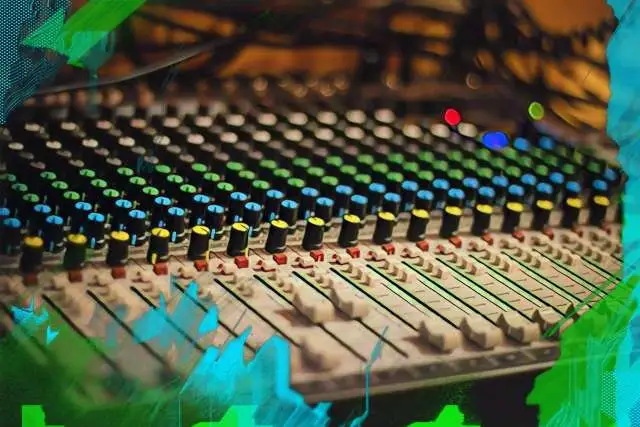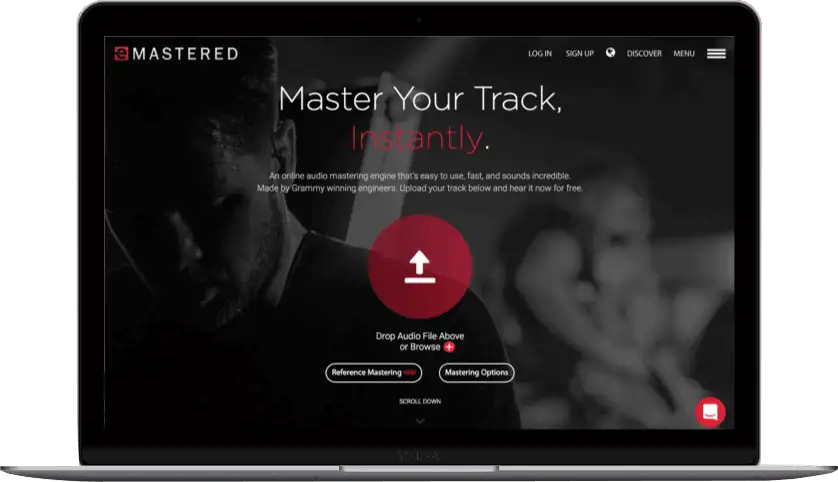Ever recorded an acoustic guitar, only to find it sounds nothing like what you heard in the room? Maybe it’s too boomy, too thin, or somehow both at the same time. Does it keep disappearing in the mix no matter how much you crank the fader? Or maybe it’s clashing with the vocals or sounding harsh when you try to brighten it up?
You’re not alone.
Acoustic guitars can be beautiful, expressive instruments. However, when it comes to mixing them, they can be surprisingly tricky.
Unfortunately, the problem gets worse when you start EQing too much . Recordings are brutally honest, and a mic picks up every little thing, from unwanted noise to room reflections. Many new engineers end up overcompensating, making drastic EQ cuts and boosts, only to end up with something unnatural, thin, or lifeless.
The good thing is that you don’t need to fight your mix or throw endless plugins at the problem, as in this guide, we’ll go through everything you need to know about how to EQ acoustic guitar.
Why Do We EQ Acoustic Guitar?
Do you even need to EQ acoustic guitar in your mix? I mean, you don’t have to. Just like you don’t have to pay your bills on time, reply to texts within a reasonable window, or avoid drinking coffee at 10 PM. But let’s be real, some things just make life easier.
If your acoustic guitar was recorded in a perfectly balanced room, with the perfect mic, played by someone with flawless technique, then yeah, maybe you could get away without touching the EQ. But in the real world? There’s a good chance it needs some help.
The trick with organic instruments like acoustic guitars is that the less you do, the better. That is, of course, if you want to keep things natural. Over-EQing can suck the life out of an acoustic guitar and make it sound unnatural or processed.
But used the right way, EQ can be your best friend. Acoustic guitars tend to come with all sorts of little problems, from boomy low-end and boxy mids to harsh top-end, which can make them difficult to fit into a mix.
The goal isn’t to sculpt a totally new acoustic sound but rather to clean up what’s unnecessary and enhance what’s already great. So, let’s talk about how to use EQ properly.
Thoughts On Acoustic Guitar Range
Your average acoustic guitar, in standard tuning, spans from E2 (82 Hz) on the low E string to about 1.2kHz for the highest fundamental note on the fretboard.
So, does this mean you should slap a high-pass filter at 80 Hz, roll off everything above 1.2 kHz, and call it a day? Nope!
Acoustic guitars are rich with overtones, which means their character extends well beyond their fundamental frequencies. And since most acoustic guitars are recorded with microphones, you also capture the sound of the room, the mic’s frequency response, and all those little nuances that make a performance feel alive.
If you’ve got a great-sounding room, why would you want to chop off that natural space with aggressive filtering?
Now, if you’re dealing with a DI’d acoustic guitar, you’ve got a whole different story. DI signals tend to have a ton of high-end information, sometimes too much, which makes them sound brittle or unnatural. This is where EQ can help smooth things out and bring some warmth back into the mix.
So before you start cutting and boosting, it’s good to think about what you’re actually working with.
How to EQ Acoustic Guitar In a Mix
So how do you actually EQ acoustic guitar in a mix? Do you just high-pass the ultra-low-end, add some high-shelf top, and call it a day? Do you surgically carve out the mids like you’re defusing a bomb? Do you slap on a preset and hope for the best?
The truth is that there’s no single way to EQ an acoustic guitar. The right moves depend on the recording, the player, the mic, the room, the song, and everything else happening in the mix. A delicate fingerpicked part in a sparse arrangement needs a totally different approach than a big strummed country rhythm track sitting under a full band.
What Is the Ideal Tone of Your Acoustic Guitar?
What does the perfect acoustic guitar tone sound like? Well… that depends. Are we talking about a warm, mellow nylon-string? A bright, punchy steel string? A big-bodied dreadnought that fills the room, or a compact parlor guitar with a more intimate sound?
Acoustic guitars come in all shapes and sizes, and every single one has its own personality. A grand auditorium guitar might give you a balanced tone with a nice midrange focus, while a jumbo model will give you more bass and power. The woods used also play a huge role. Spruce tops tend to sound lively and bright, while mahogany leans warm and focused.
This is why there’s no one-size-fits-all approach to how you EQ acoustic guitar. A bright-sounding Taylor acoustic guitar might need some taming in the highs, while a darker Martin could use a little lift. The goal isn’t to force your acoustic guitar to sound a certain way. It’s to enhance what’s already there.
How Was the Acoustic Guitar Recorded?
Before you touch your EQ settings, ask yourself - how was the acoustic guitar recorded? Because that alone changes everything.
If it was recorded with a microphone in a room, then the room itself is a big part of the sound. A well-treated space with a good mic setup can capture depth, warmth, and natural resonance. But if the room was too small, boxy, or untreated, you might be dealing with weird reflections and boomy low-end that need some cleaning up.
On the other hand, if you’re working with a DI’d acoustic guitar, you’ve got a totally different beast. DI signals tend to sound unnaturally bright, thin, and plasticky, especially when plugged straight into an interface. That’s because you’re hearing the raw piezo or pickup signal, not the natural body of the guitar. In this case, EQ is often used to tame harshness and bring back some natural character.
How Was the Acoustic Guitar Played?
How the guitar was played is just as important as how it was recorded. A softly fingerpicked part isn’t going to need the same EQ moves as an aggressively strummed rhythm track.
Fingerpicking tends to bring out more detail in the highs and can sometimes sound thin or brittle if not balanced properly. You might need to rein in some high-end harshness while adding warmth in the mids to keep it full.
Strumming often adds more low-end and midrange buildup, which can get muddy if not controlled, and percussive playing introduces a whole new range of transients.
What Else Is Happening in the Mix?
You can EQ an acoustic guitar perfectly, but if it doesn’t fit with everything else, what’s the point? Mixing isn’t about making instruments sound great on their own. It’s about making them work together.
First, how dense is the arrangement? If it’s just one acoustic guitar and a vocal, you’ll probably want to keep things full and natural, and let the guitar take up more space. But if you’re dealing with multiple acoustic instruments, electric guitars, acoustic bass, kick drum, snare, and synths, you might need to carve out frequency ranges to make room for everything.
And how many acoustic guitar parts are there? If it’s just one, you’ll want to keep the frequency range balanced and natural. However, if there are several layers, they all have to play nicely together. One might need a bit more body, another might need to be brightened, and one might just sit in the background for texture.
The biggest mistake is EQing in a vacuum . Soloing a track and tweaking it until it sounds “perfect” means nothing if it doesn’t sit right once everything is playing together.
With that in mind, let’s take a look at how to EQ acoustic guitars in actual mixes and what kinds of EQ settings you should look for.
Frequency Ranges and EQ Settings to Consider on an Acoustic Guitar
High-Pass Filter
A high-pass filter can be your best friend in a busy mix, especially when you need to keep the acoustic guitar from getting in the way of the low-end-heavy instruments. If your mix is already packed with low-end energy, rolling off the low-end of the acoustic can clean things up and make everything sit better together.
It’s also useful if your recording has unwanted rumble, mic stand vibrations, or handling unwanted noise. A gentle high-pass filter can eliminate the stuff you don’t need without affecting the good parts of the sound.
But before you go crazy and start cutting everything below 150 Hz, think about how important the acoustic is in the mix you're working on. In folk, singer-songwriter, or solo acoustic performances, the low-end of the guitar is part of its warmth and depth, so you don’t want to strip that away. If the guitar is carrying the rhythm and body of the track, you might not need to high-pass at all.
A good approach is to sweep the filter up slowly while listening to the full mix. Start around 50-80 Hz and gradually raise it until you hear the low-end tighten up. If the mix is dense, you might push it up to 120 Hz or even 150 Hz, but if the acoustic is front and center, keeping it lower (or skipping it entirely) might be the better move.
Body, Warmth, and Mud
This is where things get tricky. The low-mids are usually between 100 Hz and 400 Hz. This range is where the acoustic guitar gets its body and warmth, but it’s also where things can start to sound muddy or boxy if there’s too much buildup.
How this range behaves depends entirely on the guitar itself and how it was recorded. A big-bodied dreadnought? Probably has a lot of natural low-end warmth. A small parlor guitar? Likely lighter in this area. Mic placement, room reflections, and even how hard the strings were played all affect what’s happening here.
That’s why I’m not going to tell you to “always cut at 250 Hz” or “always boost at 180 Hz.” There’s no magic number. Just listen to what the mix needs.
Need more warmth and fullness? Try a gentle boost somewhere in the 150-300 Hz range.
Feeling muddy or boxy? A small cut with a narrow Q around 200-350 Hz can help clean it up without making it sound thin.
Clarity
Clarity is what keeps an acoustic guitar from sounding dull, muffled, or lost in the mix. To me, it lives in the 3-4 kHz range. It's a bit of a sweet spot on most acoustic guitars where the attack of strumming and fingerpicking cuts through and helps define each note.
If the acoustic guitar is feeling a little buried, a small boost here can bring it forward and make it more articulate. Just be careful, as too much can make it sound harsh or piercing, especially if the player used a bright pick or lighter gauge strings.
When I do boost in this area, I prefer a wider Q rather than a super narrow one, as clarity isn’t just about one isolated frequency. I want to have a little lift in the frequencies surrounding the center frequency so that it blends more smoothly.
Top-End
The brilliance and percussiveness of an acoustic guitar usually live in the 10 kHz and above range. This is where you get that airy shimmer, string detail, and the subtle attack of a pick or fingernail on the strings.
If the acoustic isn’t cutting through the mix, a gentle boost in this range can add some sparkle and presence without making the midrange too aggressive. It’s especially useful if the guitar was recorded with a darker mic or played with older strings that have lost some of their brightness.
In pop and rock mixes, acoustic guitars are often more of a percussive element than a dominant melodic instrument. Think of the way strummed acoustics add energy and rhythm behind a full band. You don't necessarily need the chordal information, but rather the crisp attack of the strings that help drive the rhythm.
When boosting the top-end in this kind of mix, you’re usually looking for brightness and texture, just enough to make the transients pop without anything sounding harsh.
Low-Pass
Lastly, I like to do a little housekeeping up top by rolling off a bit of the extreme highs around 20 kHz. This shouldn't change the tone of the guitar in a noticeable way but rather create headroom and keep the top end from getting cluttered, especially in busy mixes.
When setting a low-pass filter, I solo the guitar and bring the cutoff down slowly, listening for the point where I just start to hear a difference. Then I back it off slightly. The goal is not to kill the brightness or air, but to trim the unnecessary ultra-high frequencies that don’t really contribute to the sound but still take up space.
It might seem like a tiny move, but when you’re dealing with dozens and dozens of tracks, these subtle cuts add up. A little extra clarity here and a little less high-end buildup there can make a huge difference in keeping a mix clean, open, and balanced - without touching a single fader.
Using Parametric EQs for General Shaping
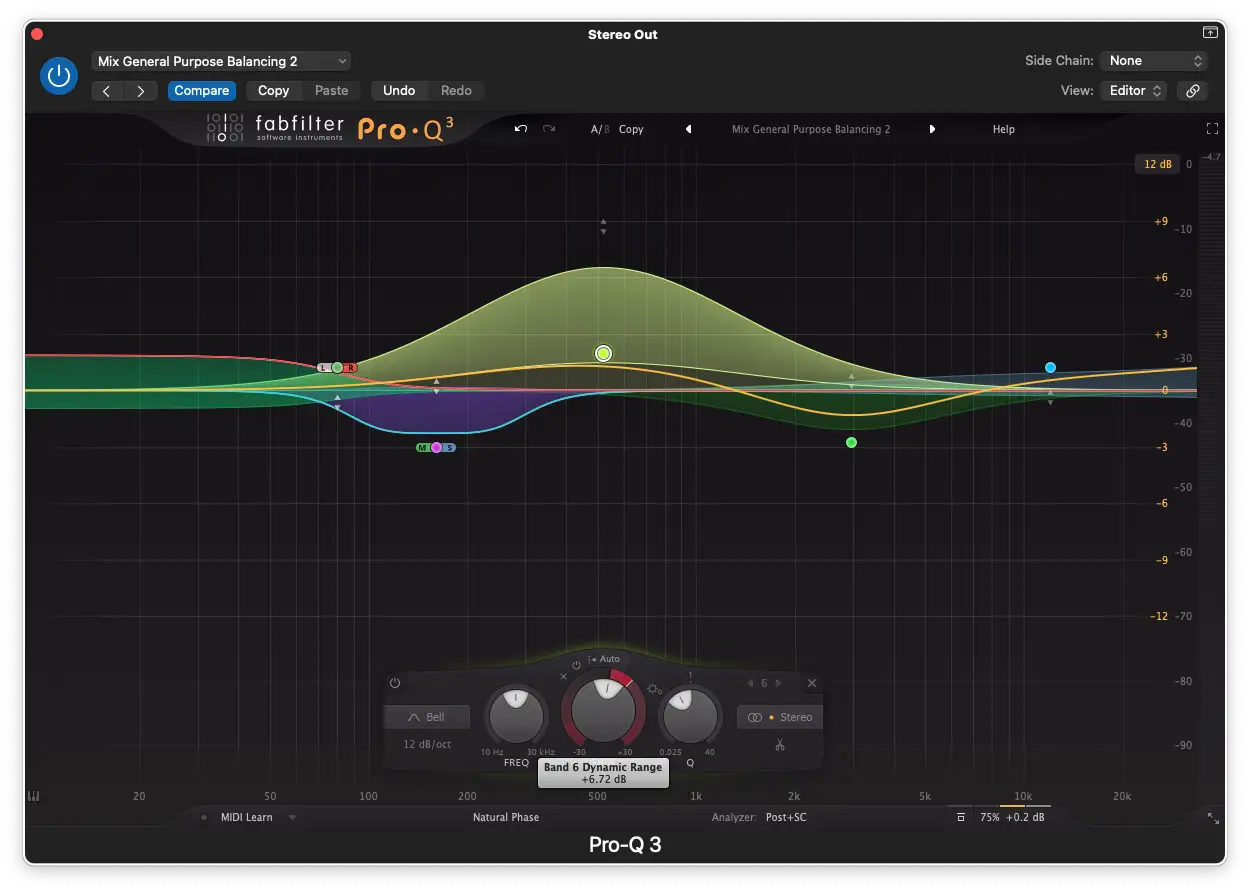
When it comes to control, nothing beats a good parametric EQ. These EQs let you dial in exactly what you need, with full control over frequency selection, gain, and bandwidth (Q). Whether you’re making broad, musical boosts or surgical cuts, a good parametric EQ lets you shape the overall tone of your acoustic guitar without introducing weird artifacts or color.
That leads to my next point, which is about "transparency." Unlike some analog-style EQs that add character or saturation, parametric EQs can be nearly invisible, allowing you to make changes without affecting the natural tone of the guitar.
They also give you the power to target problem frequencies with extreme accuracy. If there’s an annoying resonance or harsh peak, you can use a super narrow Q to notch it out without touching anything else.
This is especially useful for taming boxy low-mids or harsh upper-mids that can make an acoustic guitar sound off in a mix.
Many modern parametric EQs also come with dynamic capabilities, meaning they can act more like a multiband compressor, cutting frequencies only when they become a problem rather than applying a static cut. This is huge for controlling things like boomy low-end that only flares up on certain chords or harsh pick attack that gets aggressive in louder sections.
If you’re looking for some of the best parametric EQ plugins, here are a few that consistently get the job done:
- FabFilter Pro-Q3 – My personal favorite and one of the most versatile and transparent EQs out there. There are also plenty of powerful dynamic features and an easy-to-use interface.
- DMG Audio Equilibrium – A deeply customizable EQ with surgical precision and analog-style options if you want a little bit of character.
Using Analog EQs for Character
While parametric EQs give you total control and precision, sometimes you don’t need surgical . Sometimes, you just want vibe, and that’s where analog-style EQs come in.
If you’ve ever wondered why records from the ’50s, ’60s, and ’70s have that warm, rich, slightly gritty sound, a big part of it comes from the EQs used in those sessions. Classic analog equalizers add color, saturation, and a certain “glue” that makes everything feel more alive. Whether it’s the silky top-end of a Pultec or the punchy midrange of a Neve, these EQs do something special that’s hard to replicate with clean digital processing.
That’s why I always recommend having a few analog-style EQs in your arsenal. Even if you do most of your shaping with a parametric EQ, an analog emulation can bring depth, warmth, and personality that takes an acoustic guitar from sounding good to sounding like a record .
Here are a few of my go-to analog-style EQ plugins for acoustic guitar:
UAD Neve 1073
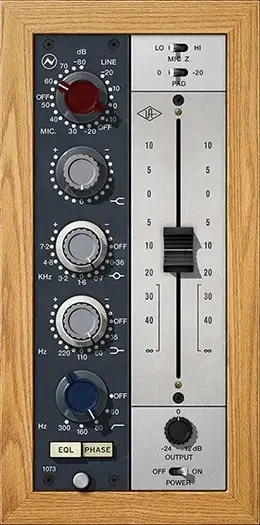
The UAD Neve 1073 is modeled after the classic Neve 1073 preamp and EQ module, which is one of the most legendary pieces of gear in recording history. This thing has been used on countless records since the early ‘70s.
The EQ section itself is simple but powerful , with just three bands and a high-pass filter:
You get a fixed High Shelf (12 kHz) for silky, musical top-end, a Mid Band with selectable frequencies (from 360 Hz to 7.2 kHz), a Low Shelf (35, 60, 110, or 220 Hz), and a High-Pass Filter (50-300 Hz) that is great for cleaning up unwanted rumble.
If you’re using the Neve 1073 on an acoustic guitar, there are a few starting points that can help shape the tone in a natural, musical way. A gentle boost in the 1.6 kHz to 3.2 kHz range (around +2 to +4 dB) can bring it forward in the mix. If things are sounding a bit muddy or boxy, I like to cut slightly around 360-700 Hz (about -2 to -3 dB).
Then, for a touch of air and sparkle, a high-shelf boost at 12 kHz (around +2 dB) can brighten the top end without sounding harsh. If I need it for the mix I'm working on, I'll also throw on a high-pass filter around 100 Hz.
Acustica Purple 3.5

The Pultec EQP-1A is one of the most magical EQs ever made. It's been used on countless iconic acoustic guitar tracks, from the warm, rich strumming on Fleetwood Mac’s Rumours to the sparkling acoustic tones of James Taylor and Simon & Garfunkel.
Legendary studios like Abbey Road, Sunset Sound, and Capitol Studios were filled with Pultecs, and, in many ways, they shaped the sound of the ‘60s and ‘70s.
While there are plenty of Pultec emulations out there, Acustica Audio’s Purple 3.5 is easily one of the most faithful and detailed recreations of the original hardware. It captures not just the EQ curves, but also the saturation, harmonics, and depth that made the original so sought after.
It's not a surgical EQ, so if you’re looking for tight, precise cuts, this isn’t the tool for that. However, if you want to add weight, warmth, and shine in a way that feels natural and musical, it’s hard to beat.
One of the coolest quirks of the Pultec design is that you can boost and cut the same frequency at the same time. It might sound counterintuitive, but this trick creates a subtle dip just above the boosted frequency, which can make an acoustic guitar feel fuller and more defined.
Some engineers in the ‘60s and ‘70s would often run instruments through a Pultec with the EQ completely off just to get the color and tone it naturally imparted. That’s how much vibe this thing brings. Even if you’re not making big acoustic guitar EQ moves, just running it through the Acustica Purple 3.5 can add a subtle depth and character.
Slate Digital FG-A Vintage
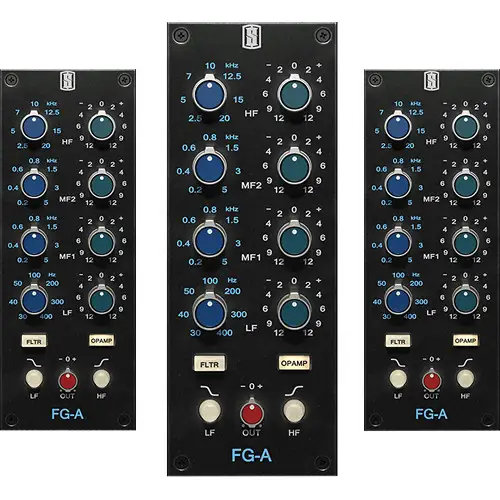
Okay, I know Fleetwood Mac was already mentioned earlier, but it's just because the band has some of my favorite acoustic guitar tones of all time. The recording was made on the API console, which comes with the API 550A channel EQ.
While Ken Caillat and Lindsey Buckingham certainly had a lot to do with the sound of the acoustic guitars on Rumours , there's not doubt that the API EQ had a major influence on it as well.
Just like the Pultec, there are hundreds of emulations of API EQs to choose from, though if I had to pick a favorite, it would have to be the Slate Digital FG-A Vintage EQ.
It perfectly emulates the API 550A's fully discrete circuitry, which has the most musical sound out of almost any analog EQ on the market. In many ways, the API is the American counterpart to the British Neve 1073 sound.
I really love the warmth on the low-mids of the API 550, especially around 200 Hz. If you ever need a little boost in the low-mids, here is a great place to start.
As for the mid-range, I'm a big fan of 5kHz on the API for acoustic guitars, though you just need a little boost. Maybe 2dB or so.
Finally, I'll play around with the high frequencies around 10kHz, whenever I need a bit of brilliance.
Soundtoys Sie-Q

Sometimes, you just want an acoustic guitar EQ that's quick and easy. That's where the Soundtoys Sie-Q Equalizer comes in. I typically reach for it when I want to make broad tonal changes to my acoustic guitar sound.
The Sie-Q was modeled after the Siemens W295b, which was a 1960s-era broadcast EQ invented by the Germans. I usually find myself using the high filter on it to pull back any harshness in the high-end or to open it up if my acoustic guitar track is too dark.
One of my favorite things about this acoustic guitar EQ is the fact that you can get pretty heavy-handed with the boosts, as the curves are very musical sounding. It's great for a final touch, especially on a bus with multiple acoustic guitars.
Final Thoughts - Getting the Perfect Acoustic Guitar Track
Learning how to EQ acoustic guitar doesn't have to be as hard as you might think.
When mixing acoustic guitars, the first thing to think about is the mix around them.
If your acoustic guitar is meant to be the star of the show, then you might want to leave it be. However, if you're layering a larger mix with a ton of other instruments like bass guitar, electric guitars, keys, and vocals, you might need to carve out frequency space for those other instruments.
As always, trust your ears and let the mix guide you!


